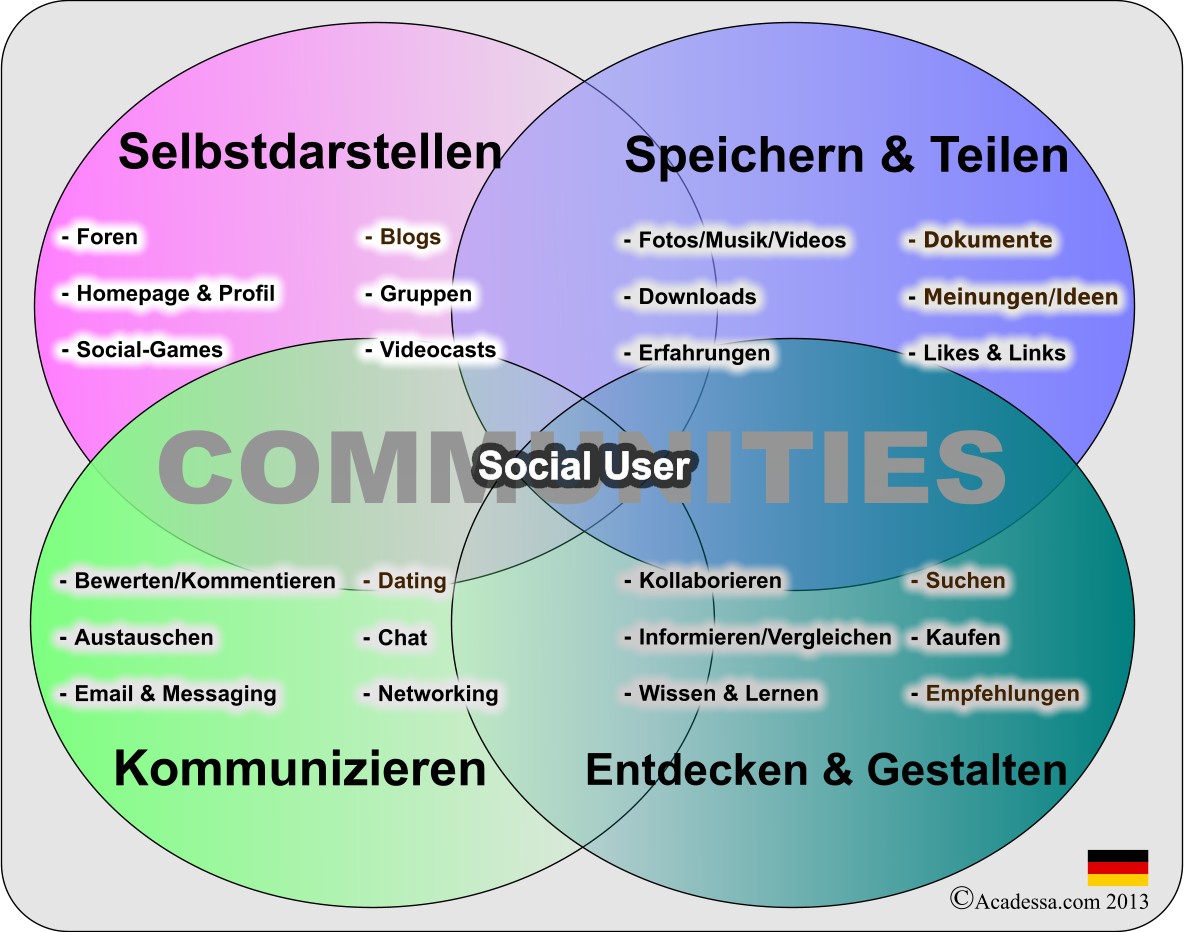Veränderungen im Sozialen Netz
Verschiedene Studien kommen zu dem Ergebnis, dass bis Ende 2012 weltweit fast 1,5 Milliarden Internetnutzer in Sozialen Netzwerken und Online-Communities aktiv waren. Für Unternehmen ergeben sich durch das „Social Web“ neue Chancen und Potentiale, wie die Nutzung von Online-Communities als Informationsquelle und als Instrument, um mit Kunden und Anwendern direkter zu kommunizieren und zu interagieren.
Infolge der deutlichen Veränderung des Nutzerverhaltens im Social Web im Vergleich zum passiven „Web 1.0“ kann auch von einem „Social User“ gesprochen werden. Die Infografik zeigt wesentliche Nutzungsszenarien (Nutzerbedürfnisse) und gruppiert diese in vier Aktivitäten. Ein großer Teil der Aktivitäten vollzieht sich in Online-Communities und sozialen Netzwerken.
Die vier Aktivitätengruppen sind (1) „Selbstdarstellen“, das (2) „Speichern und Teilen von Inhalten“, (3) „Kommunizieren“ sowie (4) „Entdecken und Gestalten“. Inhaltlich sind die vier Gruppen nicht überschneidungsfrei, sondern zeigen viele Schnittmengen. So dient bspw. „Bewerten & Kommentieren“ zwar der Kommunikation, ist aber gleichzeitig auch ein Instrument der Selbstdarstellung. „Kollaborieren“ ist eine gestalt
erische Aktivität, gleichzeitig werden aber auch Inhalte geteilt und in gewisser Weise kann auch Kollaboration der Selbstdarstellung dienen. „Social Games“ sind in jedem Fall auch ein Instrument der Kommunikation und um sich mit anderen Nutzern auszutauschen.
Vgl. Janzik (2011), Motivanalyse zu Anwenderinnovationen
Change in the Social Web
Several studies report globally 1.5 Billion active users in social networks and online communities until the end of 2012. For companies the “Social Web” offers new opportunities and potentials to establish a more direct communication and interaction with customers and users. Online communities are an ideal source of information and to start interaction.
As consequence of the changed usage patterns in the Social Web compared to the passive “Web 1.0” we will use the term “Social User”. The infographic visualizes the most important scenarios of use (needs) and groups these into four activities. The majority of these activities take part in online communities and social networks.
The four groups of activities are (1) “self-presentation”, (2) “store & share”, (3) “communicate” as well as (4) “discover & create”. The four groups are not free of content related overlaps and show several intersections. E.g. “rate/review/comment” is an important part of communication, but also an instrument of self-presentation. “Collaboration” is a creative activity, but at the same time content and ideas are shared. Somehow “collaboration” is also a way of self-presentation. “Social games” support not only self-presentation, but also communication and exchange with other users.
(Janzik, 2011, Motivanalyse zu Anwenderinnovationen)

